Review of Empirical Studies: Coaching and Feedback Planning Future
VerifiedAdded on 2023/04/07
|15
|1976
|156
Literature Review
AI Summary
This literature review examines the effectiveness of coaching and feedback mechanisms in organizational settings, drawing upon several empirical studies. The review begins by analyzing Li et al. (2011), which highlights the positive impact of feedback on employee conduct and organizational structure. It then delves into Luthans and Peterson (2004), contrasting the previous study by exploring the demotivating aspects of feedback and advocating for integrated coaching programs. Grant (2009) empirically demonstrates the superiority of coaching sessions over feedback processes alone, emphasizing cognitive and behavioral reshaping. The review also considers Davis, Huffman, and Alayan's work on coaching's psychological benefits for students, noting potential dependency issues. Finally, Heinke (2013) underscores the importance of tailoring coaching approaches to individual needs. The review concludes by suggesting that a balanced, well-integrated approach to feedback and coaching, customized to specific contexts, is crucial for maximizing employee and organizational development, while also acknowledging the limitations and biases inherent in these processes.
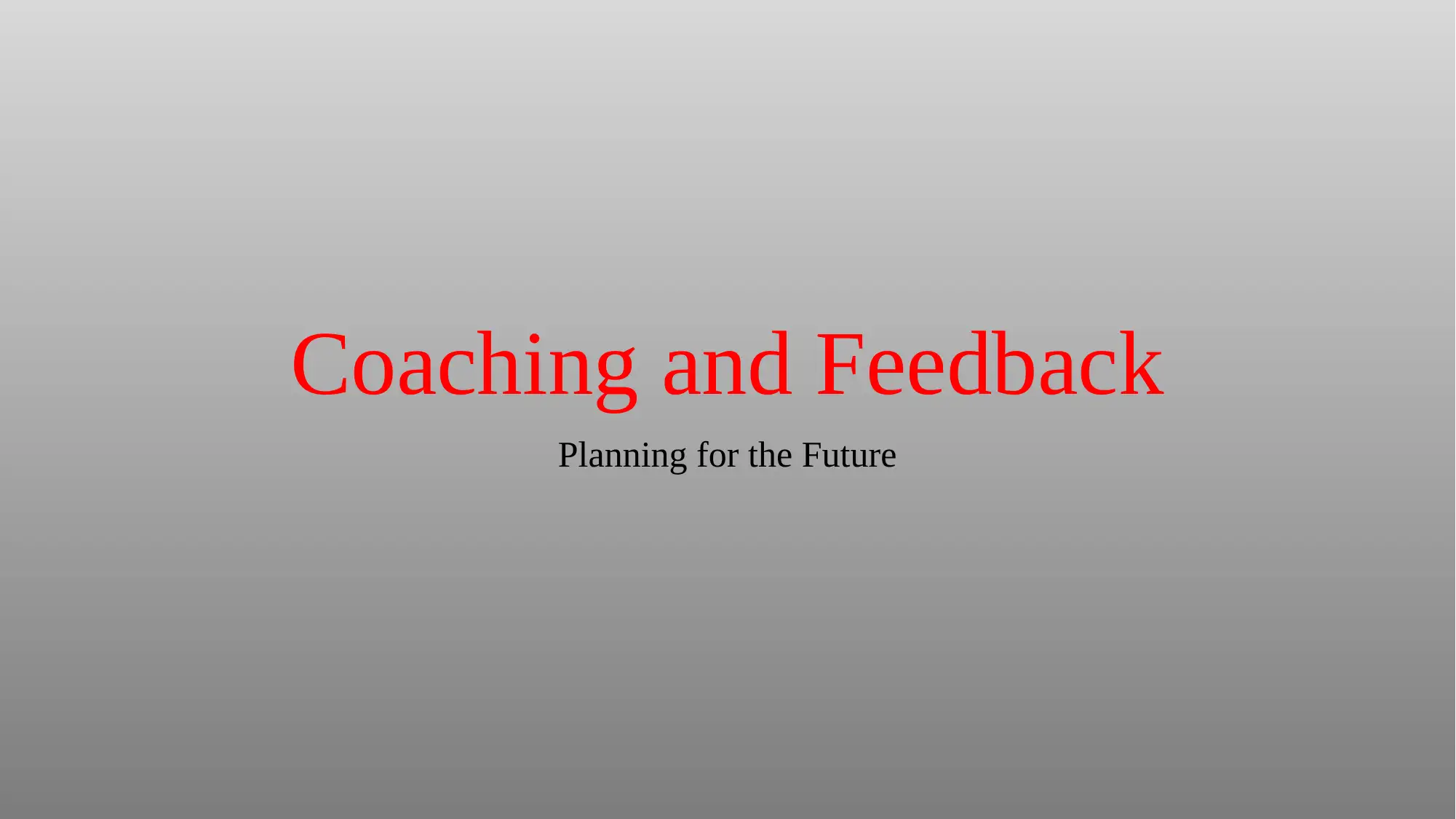
Coaching and Feedback
Planning for the Future
Planning for the Future
Paraphrase This Document
Need a fresh take? Get an instant paraphrase of this document with our AI Paraphraser
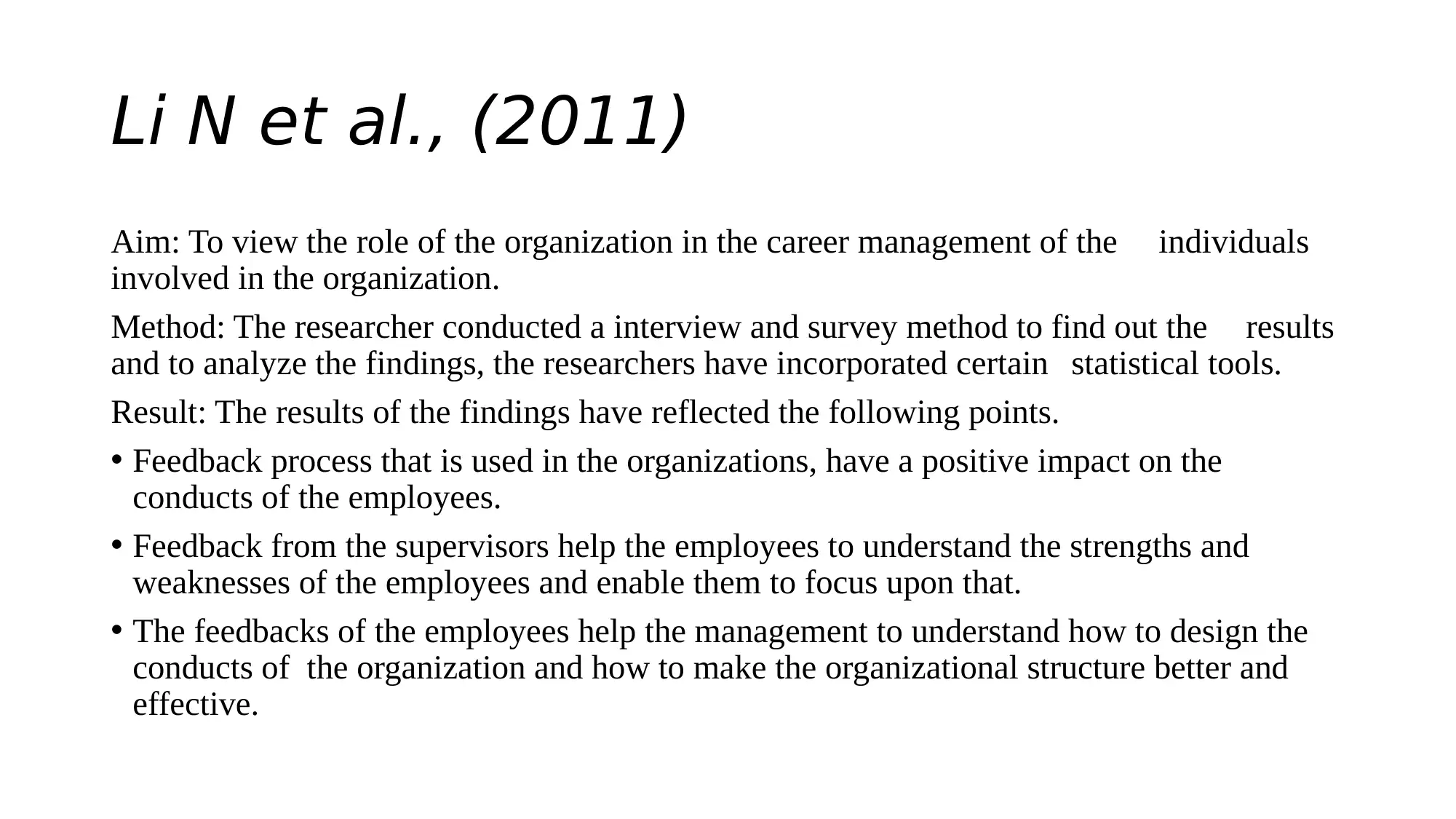
Li N et al., (2011)
Aim: To view the role of the organization in the career management of the individuals
involved in the organization.
Method: The researcher conducted a interview and survey method to find out the results
and to analyze the findings, the researchers have incorporated certain statistical tools.
Result: The results of the findings have reflected the following points.
• Feedback process that is used in the organizations, have a positive impact on the
conducts of the employees.
• Feedback from the supervisors help the employees to understand the strengths and
weaknesses of the employees and enable them to focus upon that.
• The feedbacks of the employees help the management to understand how to design the
conducts of the organization and how to make the organizational structure better and
effective.
Aim: To view the role of the organization in the career management of the individuals
involved in the organization.
Method: The researcher conducted a interview and survey method to find out the results
and to analyze the findings, the researchers have incorporated certain statistical tools.
Result: The results of the findings have reflected the following points.
• Feedback process that is used in the organizations, have a positive impact on the
conducts of the employees.
• Feedback from the supervisors help the employees to understand the strengths and
weaknesses of the employees and enable them to focus upon that.
• The feedbacks of the employees help the management to understand how to design the
conducts of the organization and how to make the organizational structure better and
effective.
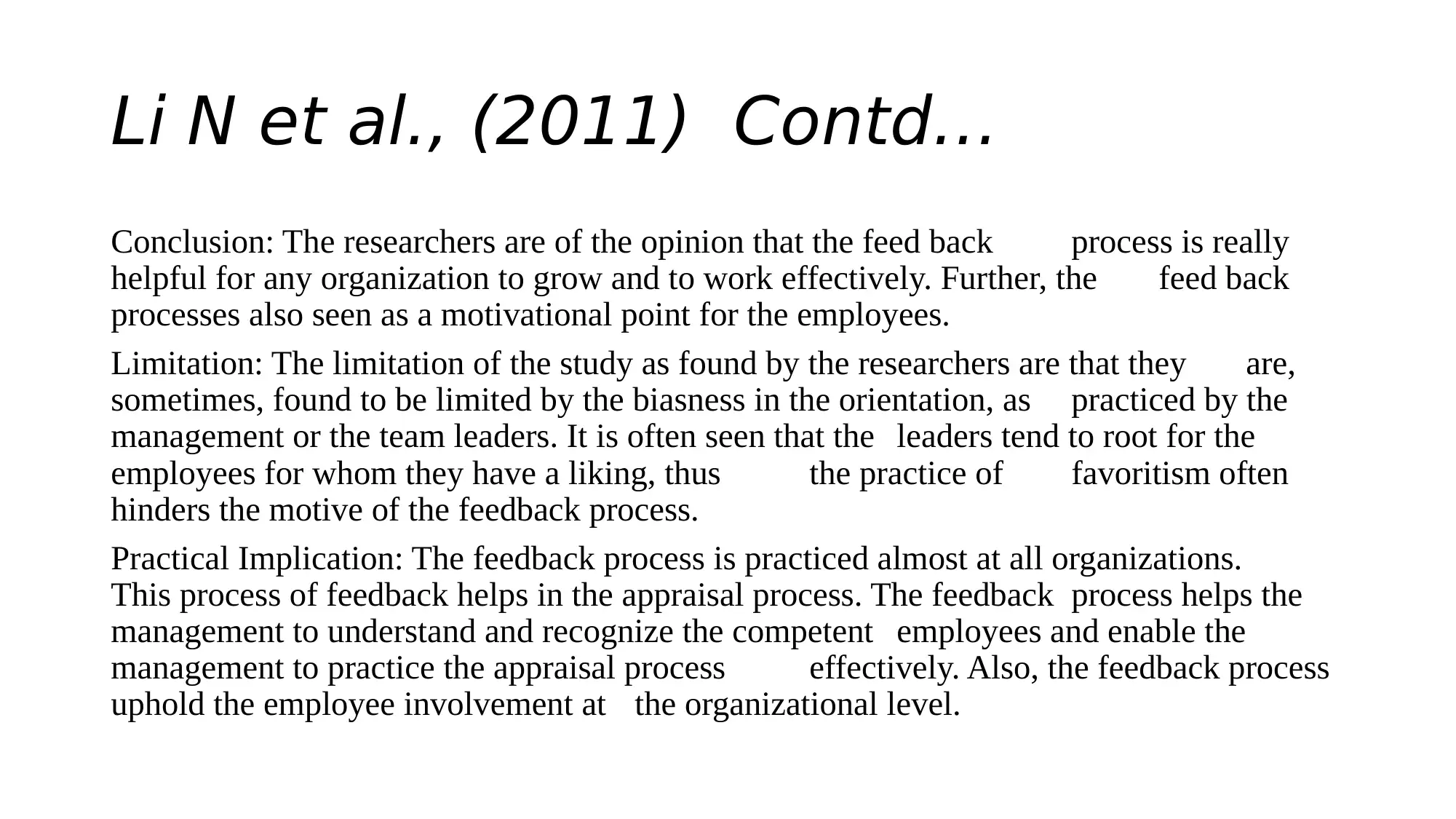
Li N et al., (2011) Contd…
Conclusion: The researchers are of the opinion that the feed back process is really
helpful for any organization to grow and to work effectively. Further, the feed back
processes also seen as a motivational point for the employees.
Limitation: The limitation of the study as found by the researchers are that they are,
sometimes, found to be limited by the biasness in the orientation, as practiced by the
management or the team leaders. It is often seen that the leaders tend to root for the
employees for whom they have a liking, thus the practice of favoritism often
hinders the motive of the feedback process.
Practical Implication: The feedback process is practiced almost at all organizations.
This process of feedback helps in the appraisal process. The feedback process helps the
management to understand and recognize the competent employees and enable the
management to practice the appraisal process effectively. Also, the feedback process
uphold the employee involvement at the organizational level.
Conclusion: The researchers are of the opinion that the feed back process is really
helpful for any organization to grow and to work effectively. Further, the feed back
processes also seen as a motivational point for the employees.
Limitation: The limitation of the study as found by the researchers are that they are,
sometimes, found to be limited by the biasness in the orientation, as practiced by the
management or the team leaders. It is often seen that the leaders tend to root for the
employees for whom they have a liking, thus the practice of favoritism often
hinders the motive of the feedback process.
Practical Implication: The feedback process is practiced almost at all organizations.
This process of feedback helps in the appraisal process. The feedback process helps the
management to understand and recognize the competent employees and enable the
management to practice the appraisal process effectively. Also, the feedback process
uphold the employee involvement at the organizational level.
⊘ This is a preview!⊘
Do you want full access?
Subscribe today to unlock all pages.

Trusted by 1+ million students worldwide

Luthans and Peterson (2004),
Aim: The aim of the research is to view the feedback system from holistic approach
and to find out the contribution of the organizations in the career management of the
employees.
Method: The research has included a 360 degree approach in the orientation. The
researchers have undergone a empirical research by using both the qualitative and
quantitative methods. They interviewed the management of the organization and the
conducted a survey upon the employees of the organization. They have also taken
some secondary data from the previous works that helped them to conduct the
empirical research.
Result: Unlike the previous research, this particular research reflects upon certain
arguments that were not explored by the previous researcher. The research has
shown that here are some negative impacts of the feedback process. The employees
have accounted that the feedback processes are demotivating to some extent. :
Aim: The aim of the research is to view the feedback system from holistic approach
and to find out the contribution of the organizations in the career management of the
employees.
Method: The research has included a 360 degree approach in the orientation. The
researchers have undergone a empirical research by using both the qualitative and
quantitative methods. They interviewed the management of the organization and the
conducted a survey upon the employees of the organization. They have also taken
some secondary data from the previous works that helped them to conduct the
empirical research.
Result: Unlike the previous research, this particular research reflects upon certain
arguments that were not explored by the previous researcher. The research has
shown that here are some negative impacts of the feedback process. The employees
have accounted that the feedback processes are demotivating to some extent. :
Paraphrase This Document
Need a fresh take? Get an instant paraphrase of this document with our AI Paraphraser
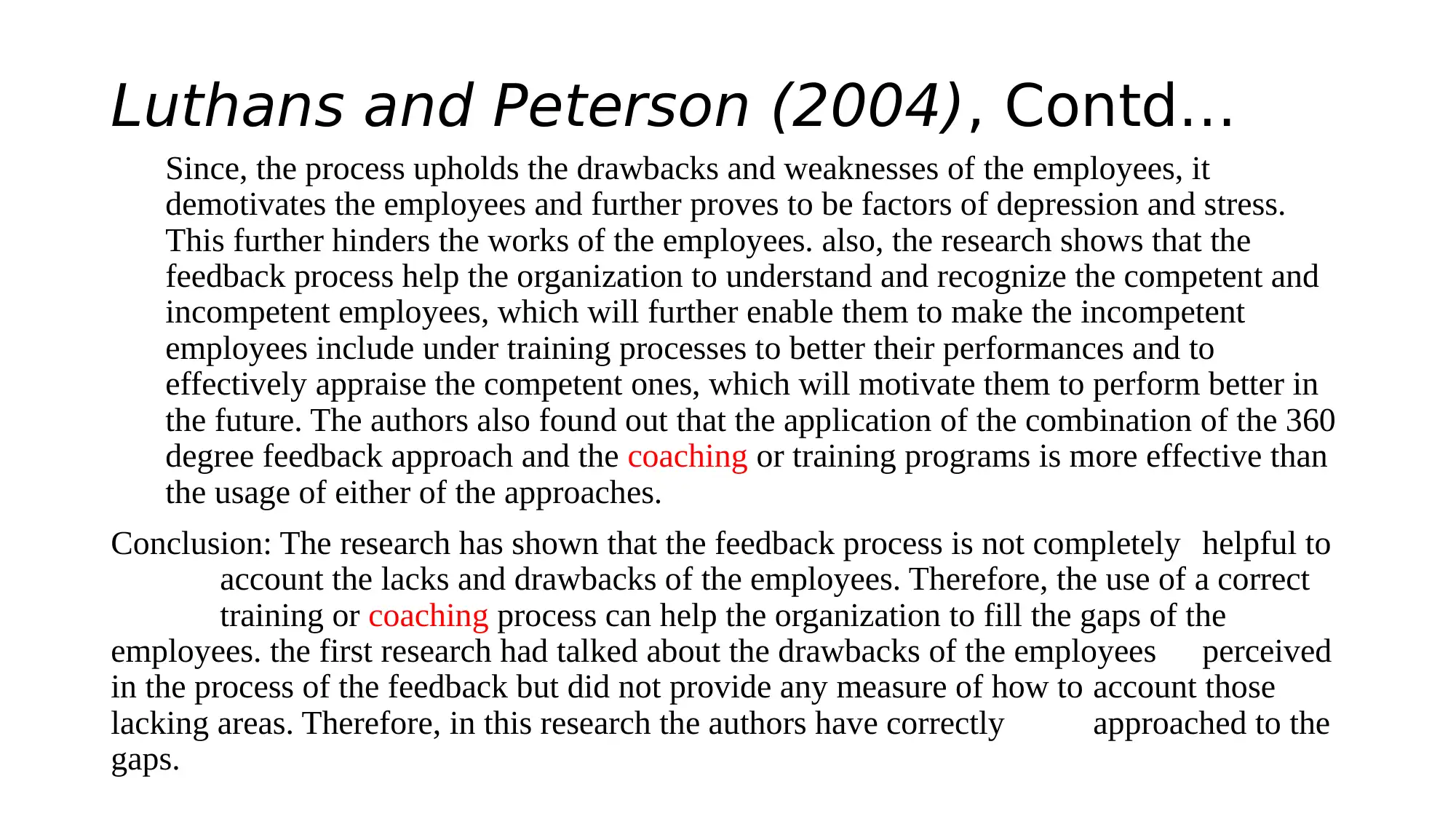
Luthans and Peterson (2004), Contd…
Since, the process upholds the drawbacks and weaknesses of the employees, it
demotivates the employees and further proves to be factors of depression and stress.
This further hinders the works of the employees. also, the research shows that the
feedback process help the organization to understand and recognize the competent and
incompetent employees, which will further enable them to make the incompetent
employees include under training processes to better their performances and to
effectively appraise the competent ones, which will motivate them to perform better in
the future. The authors also found out that the application of the combination of the 360
degree feedback approach and the coaching or training programs is more effective than
the usage of either of the approaches.
Conclusion: The research has shown that the feedback process is not completely helpful to
account the lacks and drawbacks of the employees. Therefore, the use of a correct
training or coaching process can help the organization to fill the gaps of the
employees. the first research had talked about the drawbacks of the employees perceived
in the process of the feedback but did not provide any measure of how to account those
lacking areas. Therefore, in this research the authors have correctly approached to the
gaps.
Since, the process upholds the drawbacks and weaknesses of the employees, it
demotivates the employees and further proves to be factors of depression and stress.
This further hinders the works of the employees. also, the research shows that the
feedback process help the organization to understand and recognize the competent and
incompetent employees, which will further enable them to make the incompetent
employees include under training processes to better their performances and to
effectively appraise the competent ones, which will motivate them to perform better in
the future. The authors also found out that the application of the combination of the 360
degree feedback approach and the coaching or training programs is more effective than
the usage of either of the approaches.
Conclusion: The research has shown that the feedback process is not completely helpful to
account the lacks and drawbacks of the employees. Therefore, the use of a correct
training or coaching process can help the organization to fill the gaps of the
employees. the first research had talked about the drawbacks of the employees perceived
in the process of the feedback but did not provide any measure of how to account those
lacking areas. Therefore, in this research the authors have correctly approached to the
gaps.

Luthans and Peterson (2004),
Contd…
Limitation: Though, the research ahs rightly introduced the concept of training and coaching
session, however, it still needs some areas to be revised. For example, the researchers have
talked about the negative impacts that the feedback process entails, however, they have not
provided any solution that can help the organizations to overcome this situations. Next,
the researchers have not correctly approached to the training process, they have not shown
how this training process can be and should be designed and who should be playing
what role.
Practical Implication: This particular research reflects upon certain important facets, that
can be and should be practiced by the organizations. He feedback process, as mentioned
before, helps in the appraisal process and shows the employee engagement in the
discourse of the organizational activities. However, the 360 degree approach further helps
the management to find out the aspects that limit the productivity of the workers. Also,
the training process helps and give s the employees chances to better themselves and
further, perform effectively, to be competent in the market.
Contd…
Limitation: Though, the research ahs rightly introduced the concept of training and coaching
session, however, it still needs some areas to be revised. For example, the researchers have
talked about the negative impacts that the feedback process entails, however, they have not
provided any solution that can help the organizations to overcome this situations. Next,
the researchers have not correctly approached to the training process, they have not shown
how this training process can be and should be designed and who should be playing
what role.
Practical Implication: This particular research reflects upon certain important facets, that
can be and should be practiced by the organizations. He feedback process, as mentioned
before, helps in the appraisal process and shows the employee engagement in the
discourse of the organizational activities. However, the 360 degree approach further helps
the management to find out the aspects that limit the productivity of the workers. Also,
the training process helps and give s the employees chances to better themselves and
further, perform effectively, to be competent in the market.
⊘ This is a preview!⊘
Do you want full access?
Subscribe today to unlock all pages.

Trusted by 1+ million students worldwide
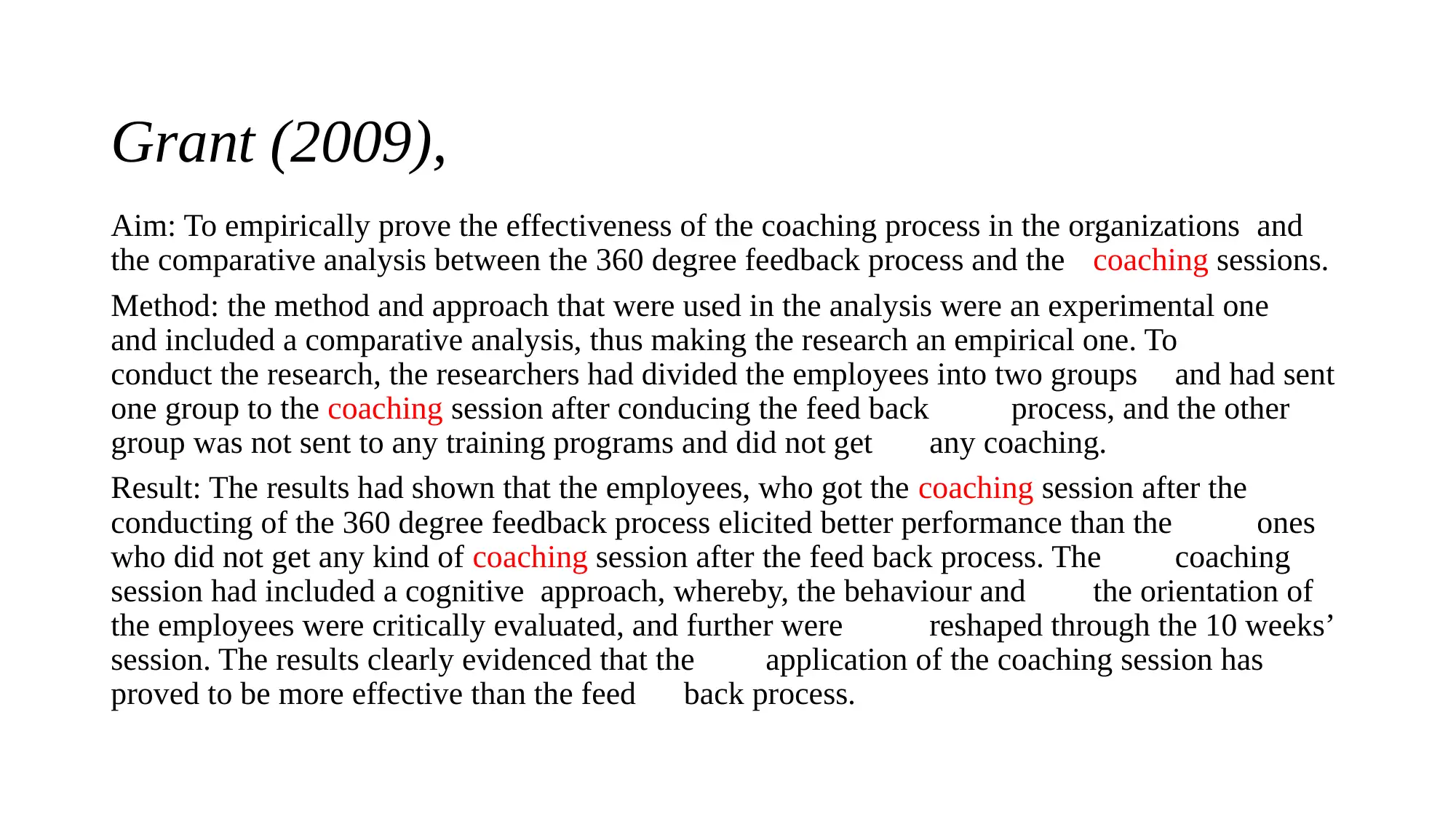
Aim: To empirically prove the effectiveness of the coaching process in the organizations and
the comparative analysis between the 360 degree feedback process and the coaching sessions.
Method: the method and approach that were used in the analysis were an experimental one
and included a comparative analysis, thus making the research an empirical one. To
conduct the research, the researchers had divided the employees into two groups and had sent
one group to the coaching session after conducing the feed back process, and the other
group was not sent to any training programs and did not get any coaching.
Result: The results had shown that the employees, who got the coaching session after the
conducting of the 360 degree feedback process elicited better performance than the ones
who did not get any kind of coaching session after the feed back process. The coaching
session had included a cognitive approach, whereby, the behaviour and the orientation of
the employees were critically evaluated, and further were reshaped through the 10 weeks’
session. The results clearly evidenced that the application of the coaching session has
proved to be more effective than the feed back process.
Grant (2009),
the comparative analysis between the 360 degree feedback process and the coaching sessions.
Method: the method and approach that were used in the analysis were an experimental one
and included a comparative analysis, thus making the research an empirical one. To
conduct the research, the researchers had divided the employees into two groups and had sent
one group to the coaching session after conducing the feed back process, and the other
group was not sent to any training programs and did not get any coaching.
Result: The results had shown that the employees, who got the coaching session after the
conducting of the 360 degree feedback process elicited better performance than the ones
who did not get any kind of coaching session after the feed back process. The coaching
session had included a cognitive approach, whereby, the behaviour and the orientation of
the employees were critically evaluated, and further were reshaped through the 10 weeks’
session. The results clearly evidenced that the application of the coaching session has
proved to be more effective than the feed back process.
Grant (2009),
Paraphrase This Document
Need a fresh take? Get an instant paraphrase of this document with our AI Paraphraser

Grant (2009), Contd…
Conclusion: The research has clearly shown that, empirically, the coaching session is
more effective than the 360 degree feedback process. The coaching session
rightly accounts the incompetent attributes of the employees and rightly suggests
ways to overcome these drawbacks, which were not included in the works of the
previous researchers.
Limitation: Since, the coaching session is conducted only after the feedback process,
therefore, there is a valid chance of missing pout certain people who are in need of
the coaching session, as the feedback process is often seen to be biased.
Practical Implication: Many of the organizations are now observed to include the
training approaches into their discourse. However, mostly, these training sessions
are seen to be conducted during the initial days of work. However, they can be,
rather should be included after the feedback process, as this can increase the
productivity of the employees and the organizations, as a whole.
Conclusion: The research has clearly shown that, empirically, the coaching session is
more effective than the 360 degree feedback process. The coaching session
rightly accounts the incompetent attributes of the employees and rightly suggests
ways to overcome these drawbacks, which were not included in the works of the
previous researchers.
Limitation: Since, the coaching session is conducted only after the feedback process,
therefore, there is a valid chance of missing pout certain people who are in need of
the coaching session, as the feedback process is often seen to be biased.
Practical Implication: Many of the organizations are now observed to include the
training approaches into their discourse. However, mostly, these training sessions
are seen to be conducted during the initial days of work. However, they can be,
rather should be included after the feedback process, as this can increase the
productivity of the employees and the organizations, as a whole.

Davis, Huffman and Alayan
Aim: The aim of their study was to identify the psychology provided by the coaching
sessions to the students and what makes them promising for the students.
Method: The study included a mixed method approach, including both the quantitative an
qualitative approach, examining the preferences of the students.
Result: The results of the study show that a number of students avail coaching sessions in
order increase their knowledge and have a sound understanding of the courses.
Coaching sessions, as according to the research help them to achieve good grades, self
assurance and self fulfilment. Also it helps them to set goals for themselves and help
them to fulfill and achieve those goals and ignite in themselves a sense of self
accomplishment.
Conclusion: The commonsense methodology of life instructing is proposed as one
approach to help these understudies in their scholarly voyage, since it improves the
understudy's feeling of having a place, self-viability, and their prosperity.
Aim: The aim of their study was to identify the psychology provided by the coaching
sessions to the students and what makes them promising for the students.
Method: The study included a mixed method approach, including both the quantitative an
qualitative approach, examining the preferences of the students.
Result: The results of the study show that a number of students avail coaching sessions in
order increase their knowledge and have a sound understanding of the courses.
Coaching sessions, as according to the research help them to achieve good grades, self
assurance and self fulfilment. Also it helps them to set goals for themselves and help
them to fulfill and achieve those goals and ignite in themselves a sense of self
accomplishment.
Conclusion: The commonsense methodology of life instructing is proposed as one
approach to help these understudies in their scholarly voyage, since it improves the
understudy's feeling of having a place, self-viability, and their prosperity.
⊘ This is a preview!⊘
Do you want full access?
Subscribe today to unlock all pages.

Trusted by 1+ million students worldwide

Davis, Huffman and Alayan Contd.
Limitation: The researchers are of the opinion that the coaching sessions, often make
the students solely dependent upon the educational programs. The method makes
them handicap, and restricts their imaginative thinking power. It is often seen that the
students are solely dependent upon the lectures and learning outcomes provided
by the teachers and they lack the ability to write a paper or topic by themselves,
without the help of the instructors or the tutors.
Practical Implication: The practical implication of the coaching sessions, as understood
from the conducted research shows that there are both positive and negative aspects of
the method. On one hand, the coaching sessions help them to achieve their
educational goals and gain a sound knowledge of the subject or the discourse.
However, at the same time, the methods restrict the growth imagination of the
students. Moreover, they are incapable of understanding their own capabilities and
become dependent upon the instructors or the teachers.
Limitation: The researchers are of the opinion that the coaching sessions, often make
the students solely dependent upon the educational programs. The method makes
them handicap, and restricts their imaginative thinking power. It is often seen that the
students are solely dependent upon the lectures and learning outcomes provided
by the teachers and they lack the ability to write a paper or topic by themselves,
without the help of the instructors or the tutors.
Practical Implication: The practical implication of the coaching sessions, as understood
from the conducted research shows that there are both positive and negative aspects of
the method. On one hand, the coaching sessions help them to achieve their
educational goals and gain a sound knowledge of the subject or the discourse.
However, at the same time, the methods restrict the growth imagination of the
students. Moreover, they are incapable of understanding their own capabilities and
become dependent upon the instructors or the teachers.
Paraphrase This Document
Need a fresh take? Get an instant paraphrase of this document with our AI Paraphraser
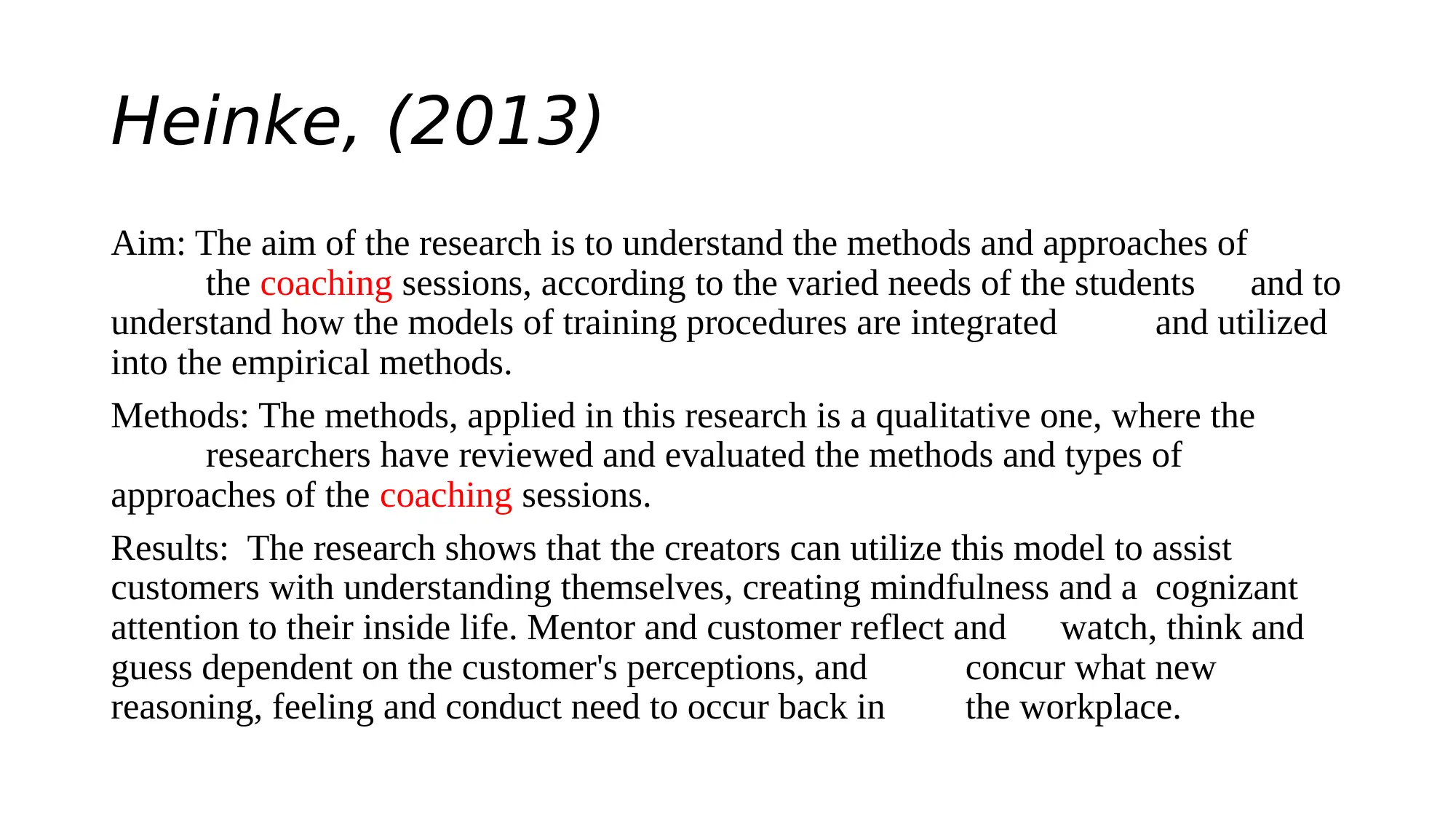
Heinke, (2013)
Aim: The aim of the research is to understand the methods and approaches of
the coaching sessions, according to the varied needs of the students and to
understand how the models of training procedures are integrated and utilized
into the empirical methods.
Methods: The methods, applied in this research is a qualitative one, where the
researchers have reviewed and evaluated the methods and types of
approaches of the coaching sessions.
Results: The research shows that the creators can utilize this model to assist
customers with understanding themselves, creating mindfulness and a cognizant
attention to their inside life. Mentor and customer reflect and watch, think and
guess dependent on the customer's perceptions, and concur what new
reasoning, feeling and conduct need to occur back in the workplace.
Aim: The aim of the research is to understand the methods and approaches of
the coaching sessions, according to the varied needs of the students and to
understand how the models of training procedures are integrated and utilized
into the empirical methods.
Methods: The methods, applied in this research is a qualitative one, where the
researchers have reviewed and evaluated the methods and types of
approaches of the coaching sessions.
Results: The research shows that the creators can utilize this model to assist
customers with understanding themselves, creating mindfulness and a cognizant
attention to their inside life. Mentor and customer reflect and watch, think and
guess dependent on the customer's perceptions, and concur what new
reasoning, feeling and conduct need to occur back in the workplace.

Heinke, (2013) Contd…
Conclusion: The research has shown that the mentors and the instructors
can include various approaches by understanding the orientations
of the students and the requirements in the discourse. Further, the
instructors must recognize the distinctive characters of each of the
methods to rightly include them in the approach.
Practical Implication: The coaching sessions are now greatly in use, in
both at the organizational levels and for the students of all
sections. Therefore, a correct understanding of each of these methods
and a right approach to these, and the correct usages of the same can
prove to be beneficial for the students as well as for the employees.
Conclusion: The research has shown that the mentors and the instructors
can include various approaches by understanding the orientations
of the students and the requirements in the discourse. Further, the
instructors must recognize the distinctive characters of each of the
methods to rightly include them in the approach.
Practical Implication: The coaching sessions are now greatly in use, in
both at the organizational levels and for the students of all
sections. Therefore, a correct understanding of each of these methods
and a right approach to these, and the correct usages of the same can
prove to be beneficial for the students as well as for the employees.
⊘ This is a preview!⊘
Do you want full access?
Subscribe today to unlock all pages.

Trusted by 1+ million students worldwide
1 out of 15
Related Documents
Your All-in-One AI-Powered Toolkit for Academic Success.
+13062052269
info@desklib.com
Available 24*7 on WhatsApp / Email
![[object Object]](/_next/static/media/star-bottom.7253800d.svg)
Unlock your academic potential
Copyright © 2020–2025 A2Z Services. All Rights Reserved. Developed and managed by ZUCOL.





